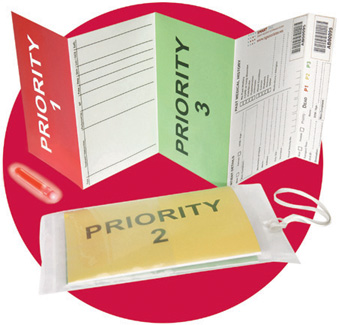Triage tag
|
WikiDoc Resources for Triage tag |
|
Articles |
|---|
|
Most recent articles on Triage tag |
|
Media |
|
Evidence Based Medicine |
|
Clinical Trials |
|
Ongoing Trials on Triage tag at Clinical Trials.gov Clinical Trials on Triage tag at Google
|
|
Guidelines / Policies / Govt |
|
US National Guidelines Clearinghouse on Triage tag
|
|
Books |
|
News |
|
Commentary |
|
Definitions |
|
Patient Resources / Community |
|
Patient resources on Triage tag Discussion groups on Triage tag Patient Handouts on Triage tag Directions to Hospitals Treating Triage tag Risk calculators and risk factors for Triage tag
|
|
Healthcare Provider Resources |
|
Causes & Risk Factors for Triage tag |
|
Continuing Medical Education (CME) |
|
International |
|
|
|
Business |
|
Experimental / Informatics |
Editor-In-Chief: C. Michael Gibson, M.S., M.D. [1]
Overview
Triage Tags is a tool first responders and medical personnel use during a mass casuality incident i.e., triage. With the aide of the triage tags, the first-arriving personnel are able to effectively and efficiently distribute the limited resources and provide the necessary immediate care for the victims until more help arrives. The concept behind triage tags was first introduced by Baron Dominique Jean Larrey, a French surgeon in Napoleon’s army. Simple Triage and Rapid Treatment (START) is a strategy that the first responders and medical personnel employ to evaluate the severity of injury of each victim as quickly as possible and tag the victims in about 30-60 seconds. The triage tags are placed near the head and are used to better separate the victims so that when more help arrives, the patients are easily recognizable for the extra help to ascertain the most dire cases.
Design
A triage tag is two-sided, but the actual layout of the sections vary between states and between governmental agencies. It is common nowadays to use triage tags to allow first responders to have a better handle of the victims during a triage. There is not a universal agreement in the design of a triage tag, so each state has implemented their own version to meet their needs.
Dynamic Triage Tag
Another popular Triage Tag is the Smart Tag with its unique folded design means that effective triage is quick and simple, but most importantly it allows casualties to be re-triaged without having to replace the tag. It has been adopted as the standard triage tag for New York, Connecticut, Philadelphia, Boston and Nevada.
Standard Sections Of A Triage Tag
The basic sections of a triage tag include:
- The four colors of triage and they come in the form of:
- Black (Deceased) which entails no care needed
- Red (Immediate) which entails life threatening injuries
- Yellow (Delayed) which entails non-life threatening injuries
- Green: (Minor) which entails minor injuries
- A section informing medical personnel of the patient’s vital signs along with the treatment administered.
- A section on the patient’s demographics i.e., gender, residential address, etc. and the patient’s medical history.
- A section with a full pictorial view of the human body. The medical personnel indicates which parts of the body are injured.
Categories
There are three basic categories of a triage tag (from top-to-bottom):
- tear off sections to label the victim properly in terms of severity of injury and to inform other medical personnel, that may arrive later, of the victim’s status.
- main body for the first responders to fill out during their assessment of the patient. This portion will stay with the patient.
- peel off stickers to keep a record of what transportation or treatment was provided to the victim.
Benefits
A benefit in using the triage tag, besides the fact of improving traffic flow and increasing distributed care among injured patients is during the collection of data. The fill-in slots on the triage tags do not need to be filled out all at once. Information can be obtained and added onto the triage tag throughout the triage. There are cases which a patient’s medical condition changes while still in triage, medical personnel would just tag the patient again with the updated information and label the tags sequentially.
The other option is to use a tag which can be altered and where the priority can go up or down. This eliminates the need to re-tag the patient.
Examples of Types
- The military uses the MT-137 design while Maryland and New Jersey use their customized version.
- The(METTAG Medical Emergency Triage Tags) was developed in the early 1970s and is widely used among the U.S. military, federal, state, and local agencies, and others.
- Another example of a triage tags is the dynamic folding tag from TSG Associates based in the UK Smart Tag. This was adopted by the State of NY in 2004, the British Military in 2002, used by London Ambulance Service in the terrorist bombings of 2005 and used by the combined forces Afganistan in 2006. An older style dynamic card is the "Cruciform", used in parts of the UK including some of the North Sea oil industry and used by the Royal London Hospital during the London bombings in 2005.
- New York, Philadelphia, Boston and Nevada have chosen the Smart Tag with its folded design means that effective triage is quick and simple.
- The States of Connecticut and Massachusetts also mandated the Smart Tag for state wide use.
- Maryland has a more detailed customized design of a triage tag
- New Jersey also has a more detailed customized design
- Community Emergency Response Teams carry color-coded flagging tape for triage use.
Related Chapters
- Emergency Medical Technician
- First responders
- Health Insurance Portability and Accountability Act (HIPAA)
- MSEHPA
- Client confidentiality
External Links
- http://www.tsgassociates.co.uk/English/Civilian/products/smart_tag.htm
- http://www.state.nj.us/health/ems/documents/njdisastertag.pdf
- http://www.miemss.umaryland.edu/MDTriage.pdf